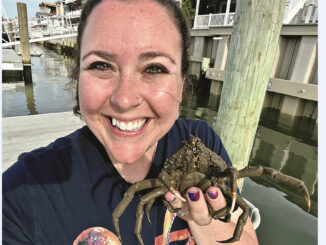
Big Blue Whale
By Kathy KrankingMake way for the blue whale—the most gigantic animal on Earth!

Its body is as long as three school buses. Its tongue weighs as much as an elephant. And its heart is more than 640 times heavier than yours. No doubt about it—a blue whale is beyond big!
This amazing whale lives in all the world’s oceans. Its body is shaped like a submarine, which helps the whale glide smoothly through the water. It moves its tail—which is about as wide as a giraffe is tall—up and down to swim. And it uses its flippers to steer.
But there’s a lot more to the blue whale than its size. Keep reading for a whale of a story.

BIG GULPS
As you might expect, a blue whale eats huge amounts of food: It can take bigger mouthfuls than any other animal in the world. But as you might not expect, the food it eats is very small. A blue whale’s diet is made up mainly of shrimp-like creatures called krill, each of which is about the length of your pinky. An adult blue whale can eat more than one and a half million krill a day!
The whale doesn’t chew up all that krill, though. That’s because it can’t chew—it doesn’t have any teeth. Instead, it has long, bristly stuff called baleen in its mouth. Like the teeth of a comb, the baleen hangs from each side of the whale’s upper jaw.
When the whale finds a big cloud of krill to eat, it plunges right through the middle of the cloud, mouth wide open. Along the whale’s throat are long grooves. These are like pleats that can open up to “super size” the whale’s throat.
Once the whale has a big mouthful, it closes its jaws and uses its tongue to squeeze all the water back out through the comb-like baleen. The krill can’t fit through the baleen, so they’re trapped. Then the whale licks them off the baleen and swallows them whole. Gulp!
WHALE TALK
Blue whales are more than just big eaters. They’re big talkers, too. They grunt, hum, moan, click, and make other sounds to communicate with each other. And they’re among the loudest animals on Earth. They can hear each other’s calls from halfway across the ocean!
But lately, whales are having trouble hearing each other. Human-created noises in the ocean—such as the rumble of engines on big ships—are drowning out the whales’ calls. This could make it difficult for them to find mates.

THAR SHE BLOWS!
You may have seen cartoons or drawings showing a whale spouting a fountain of water, but that’s not really what happens. A blue whale is a mammal, as you are. And just as you do, it needs to breathe air. It does this by coming to the surface and taking in air through two blowholes on the top of its head. But before it inhales, it exhales the old air left in its lungs. That breath is warmer than the air, so it looks just like your breath does on a cold day. Before the whale goes back underwater, the blowholes close tight to keep water out.
Sometimes, as the whale surfaces, a small amount of water that pools around the blowhole may be included in its spout.
ON THE MOVE
Blue whales really get around. They may migrate thousands of miles in a year. During summer, most of them travel toward colder waters where there is more food. Then, in winter, they head back toward the equator to mate and have babies, called calves.
A blue whale mom gives birth to one calf at a time. When the calf is born, it is already one of the biggest animals in the world—about 6 times as long as you are tall! It will nurse from its mom for about 6 to 18 months, at first drinking as much as 50 gallons of her rich milk a day!
FUTURE HOPES
Baby blue whales have a greater chance of growing up and living long lives than they used to. In the first half of the 1900s, blue whales were hunted until they almost disappeared. Blue whales are still endangered, but with protection their numbers are growing.
Scientists are trying to learn as much as they can about these giants in order to help them. They want to be sure blue whales remain an important part of our oceans forever.
















